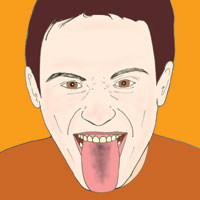

 At the Update Pharmacy, senior medicines counter assistant Hannah comes into the dispensary and says to pharmacist David Spencer: “David, there’s a man out in the shop poking his tongue out at the girls – and it’s not a pretty sight! I think he might be high on something.”
At the Update Pharmacy, senior medicines counter assistant Hannah comes into the dispensary and says to pharmacist David Spencer: “David, there’s a man out in the shop poking his tongue out at the girls – and it’s not a pretty sight! I think he might be high on something.”
“OK, I’ll sort it out,” says David and goes out into the shop where he is confronted by a man poking his tongue out at him.
“Excuse me, sir,” the man says, “can you sort this out for me?”
David has a quick look at the man’s tongue. The central portion is blackish in colour and the papillae enlarged.
“I’ll try, and you can put your tongue back in now,” David replies.
“Have you had this problem for long and does it hurt at all?”
“I’ve had it about a week. It doesn’t hurt.”
“Tell me,” David continues, “do you smoke or drink?”
“I have the odd ciggie and a little drink now and again. But God’s truth, neither to excess.”
“Do you take drugs?”
“Only what the doc prescribed.”
“Do you know what they are?”
The man fishes out of his pocket crumpled packets of olanzapine, lithium carbonate and valproate tablets.
“Do you take these regularly?” David asks.
“Oh yes, sir – when I remember.”
“For how long?”
“These two,” says the man holding out the lithium and valproate, “for a long time, sir. This one,” he says, pointing to the olanzapine, “just about a month, sir.”
Questions
1. What is this man’s condition likely to be?
2. What are the potential causes or contributory factors? What is the most likely cause in this case?
3. What is the treatment?
Answers
1. Black hairy tongue (BHT), a benign, usually symptomless self-limiting disorder, characterised by abnormally hypertrophied and elongated filiform papillae on the surface of the tongue, usually accompanied by a black or brownish discoloration. BHT is caused by defective desquamation of the dorsal surface of the tongue, which prevents normal debridement. The overgrown papillae collect debris, bacteria, fungi or other foreign materials, contributing to the discoloration and possibly also to taste alterations, nausea, halitosis, and pain or burning of the tongue.
2. These include smoking, alcohol, chronic dry mouth (xerostomia), poor oral hygiene, drugs of abuse (particularly smoking drugs such as crack cocaine), oxidizing mouthwashes (eg hydrogen peroxide), recent radiation therapy, trigeminal neuralgia, cancer, AIDS, prescribed drugs. The latter include antibiotics, xerostomia-inducing drugs (antimuscarinics, antidepressants, antihypertensives), bismuth and olanzapine (the most likely cause in this case).
3. Identification and removal of any inducing drug. Meticulous oral hygiene and cessation of modifiable predisposing factors (eg smoking, oxidizing mouthwashes). Brushing or scraping of the tongue. There are several pharmacological treatments, including topical 50 per cent trichloroacetic acid, antifungals, triamcinolone acetonide, 40 per cent urea solution, gentian violet, salicylic acid, vitamin B complex, thymol, salicylic acid, and topical or oral retinoids (eg isotretinoin), all with only anecdotal evidence of effectiveness. As a last resort, the papillae can be clipped or removed by carbon dioxide laser burning or electrodesiccation.

